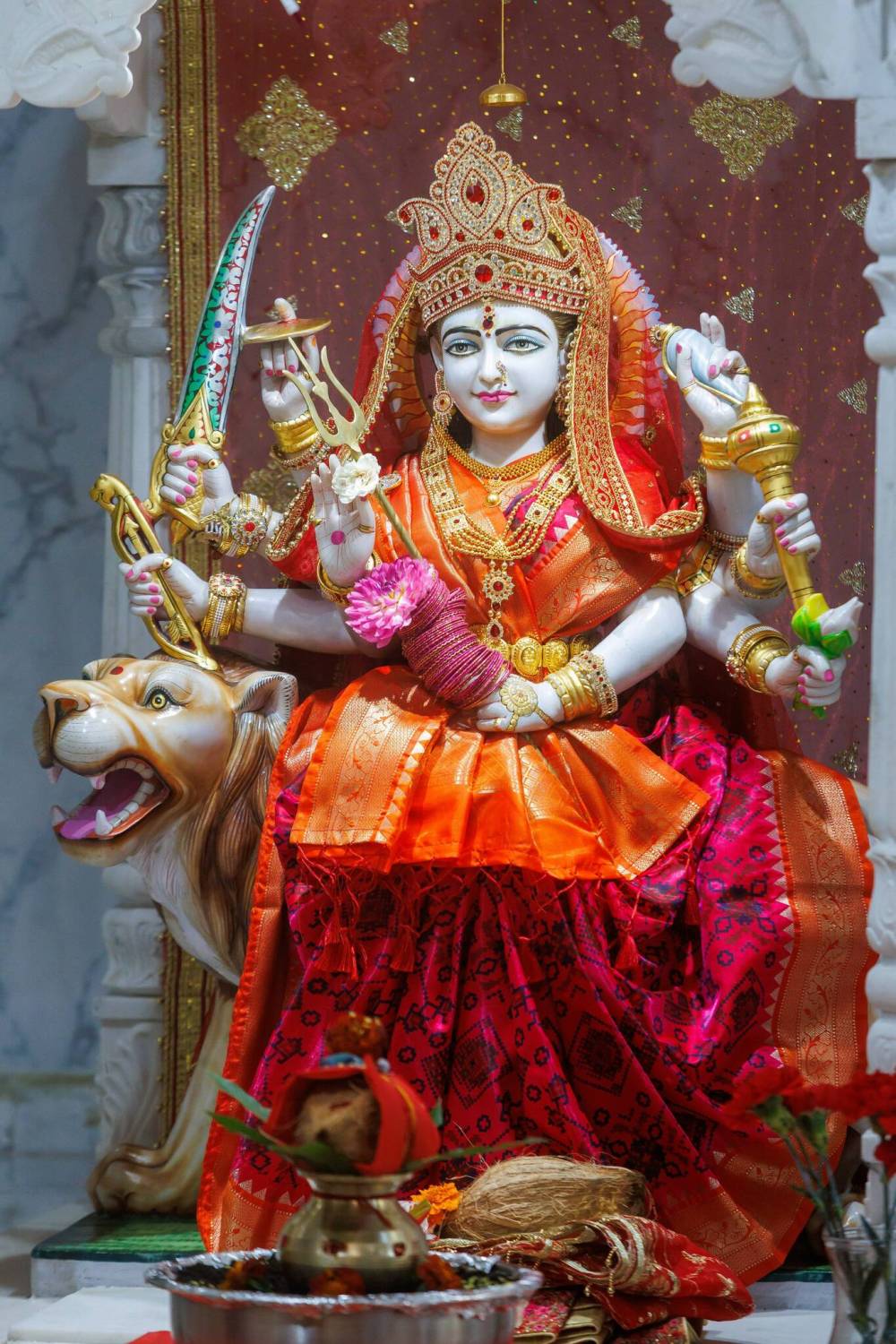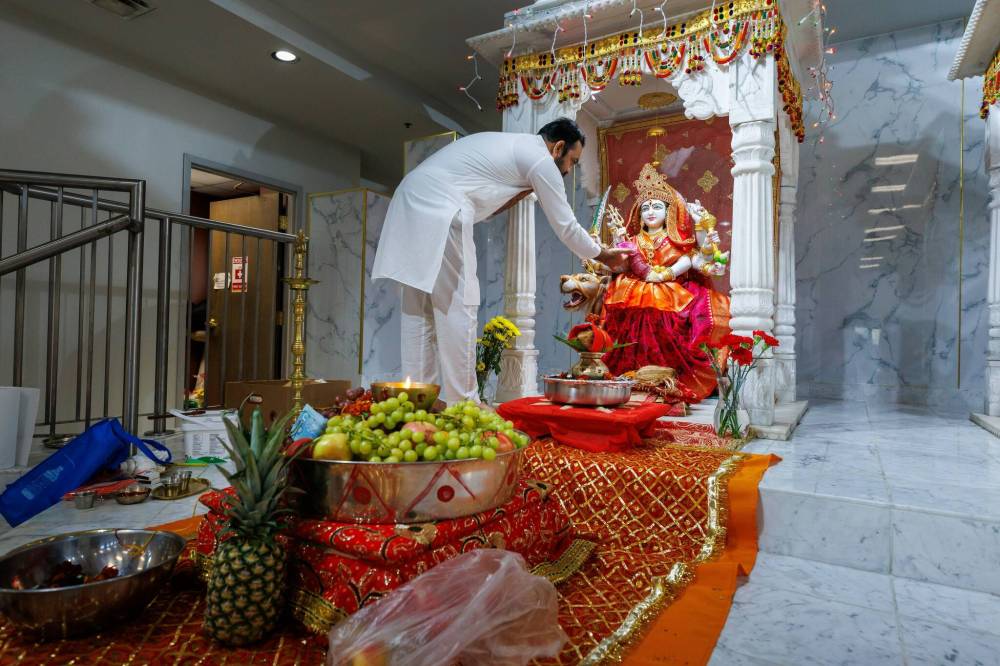Murtis a sacred part of Hinduism
Mounted on altars in the temple, they symbolize embodiment of the divine
Advertisement
Read this article for free:
or
Already have an account? Log in here »
To continue reading, please subscribe:
Monthly Digital Subscription
$1 per week for 24 weeks*
- Enjoy unlimited reading on winnipegfreepress.com
- Read the E-Edition, our digital replica newspaper
- Access News Break, our award-winning app
- Play interactive puzzles
*Billed as $4.00 plus GST every four weeks. After 24 weeks, price increases to the regular rate of $19.00 plus GST every four weeks. Offer available to new and qualified returning subscribers only. Cancel any time.
Monthly Digital Subscription
$4.75/week*
- Enjoy unlimited reading on winnipegfreepress.com
- Read the E-Edition, our digital replica newspaper
- Access News Break, our award-winning app
- Play interactive puzzles
*Billed as $19 plus GST every four weeks. Cancel any time.
To continue reading, please subscribe:
Add Winnipeg Free Press access to your Brandon Sun subscription for only
$1 for the first 4 weeks*
*$1 will be added to your next bill. After your 4 weeks access is complete your rate will increase by $0.00 a X percent off the regular rate.
Read unlimited articles for free today:
or
Already have an account? Log in here »
Upon entering a local Hindu prayer hall, you will notice radiant murtis mounted on the altars in the temple. In Sanskrit, the word murti means having a definite form and refers to the sacred representation of a Hindu deity. At the Hindu Society of Manitoba (HSM) temples in Winnipeg, the large-sized, marble murtis have been made in and imported from India.
The way Hindus worship, in connection to murtis, often has been misjudged and inappropriately described as idol worship. Murtis are not statues, objects or images being worshipped. The divine energy understood to manifest through murtis serves as the focal point of worship in the Hindu faith. Simply put, murtis symbolize the embodiment of the divine.
Why are murtis in Hindu temples dressed? You will notice they are draped in beautiful, pristine clothing, accompanied with adornments. When murtis are carved, they are created with clothing ornately painted on them. Serving as a form of worship, dressing murtis are additional adornments.

MIKE DEAL / FREE PRESS
The Goddess Durga murti at the St. Anne’s Road temple. The marble murtis at the Hindu Society of Manitoba temples in Winnipeg are made of marble and imported from India.
Pandit Venkat Machiraju, one of the HSM’s priests, says dressing murtis, along with first bathing them, are rituals performed to cultivate a closer connection to God.
“The more rituals you can perform and the more time you can spend, the more relations you develop with God,” he says. “When you only pray, the problem is there is only a mental involvement. There is no physical involvement. When you do rituals, there are actually senses involved, forming a love between God and devotees and for that devotees need to get involved mentally, physically and emotionally with their worship.”
Being formally trained and fully purified in spiritual worship, Hindu priests venerate murtis by performing rituals such as washing the hands and feet of the murti, applying kumkum (red powder) and chandan (sandalwood paste) on the murti, tying janeu (sacred thread) across the murti and offering water and jyot, or light to the murti.
In Winnipeg, community members, mainly elders, carry out dressing the murtis at both HSM temples. According to HSM president Anita Roy, a team of 6-7 volunteers complete the rituals of bathing the murtis at the St. Anne’s Road temple and dressing them regularly each month as well as before religious festivals and for other special temple occasions.
While the rituals are detail-specific and time-consuming, they are tremendously meaningful. In preparation of the nine-night Sharad Navratri festival honouring Goddess Durga, or Durga Mata, which commenced Sept. 22 and runs until Oct. 1, culminating with Vijaya Dashami (the victory of Goddess Durga over demon King Mahishasura and the victory of Lord Rama over demon King Ravana), the volunteers changed the clothes of all the murtis and adorned them. Prior to each evening of the festival, the clothing of Durga Mata is changed with a different saree every night.
Devotees participate in dressing and adorning the murtis by making offerings to the deities. They donate sarees and other pre-made clothes specifically designed for the murtis.
During Navratri, besides ornate, bright-coloured sarees, devotees also donate decorative chunnis or chunris, shawls or scarves, usually in red or maroon hues, to be draped over the head and shoulders of Durga Mata as a sign of respect, humility and protection. As well, devotees donate adornments, including bracelets and bindis to embellish the murti.
While these pieces beautify the Goddess Durga, they are not merely decorative. They signify the spiritual wealth of Durga Mata, representing grace, strength, devotion, power and peace. The complete adorning of the Goddess Durga, called Mata Rani Shringar, is a form of worship to the deity and is to seek blessings. By adorning the murti, devotees are able to better personally connect to the deity. Devotees also offer flowers, garlands and incense sticks as well as fruits, sweets and money to the murtis. All of these rituals are ways to extend your time dedicated to devotion.

MIKE DEAL / FREE PRESS
Pandit Shrikant Sharma performs rituals for the Goddess Durga murti at the Hindu Society of Manitoba temple on St. Anne’s Road.
After murtis are carved, they are not made only for aesthetic purposes. To this point, Machiraju asks, “What are you the devotee doing? Murtis do not have power by themselves. Murtis are basically stone. We actually give power to the murtis. The power of deities comes from our prayers and rituals. That power is infused back onto devotees.”
At a time now, across all faiths, when interest in having a spiritual direction in one’s life and attendance for services at places of worship are waning, being physically involved in your worship does not only serve as a focal point for your worship. It can be a starting point for your worship. Becoming more physically involved in worship, in whatever ways respective of different faiths, can help one move away from an abstract sense of God and move towards a more tangible connection to divinity via absorbing the spiritual vibes of staying calm, having serenity and being mindful.
“As you have more physical and mental involvement in your worship, over a period of time, you will start to develop an emotional connection to God,” Machiraju says.
Romona Goomansingh, PhD is an educator, freelance writer and author in Winnipeg.
The Free Press is committed to covering faith in Manitoba. If you appreciate that coverage, help us do more! Your contribution of $10, $25 or more will allow us to deepen our reporting about faith in the province. Thanks! BECOME A FAITH JOURNALISM SUPPORTER
The Free Press acknowledges the financial support it receives from members of the city’s faith community, which makes our coverage of religion possible.


